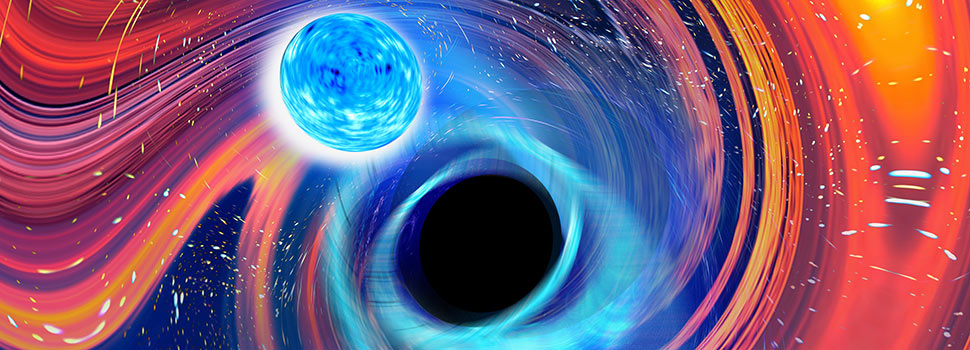It took that long for the gravitational waves from two black holes gobbling up their neutron star companions to finally hit Earth.
This first-ever detection of a black hole merging with a neutron star occurred during the second half of the LIGO and Virgo detectors third observing run, called O3b. Although multiple observatories carried out several follow-up observations, none observed light from either event, consistent with the measured masses and distances.

Artistic illustration inspired by the black hole-neutron star merger. Credit: Carl Knox, OzGrav/Swinburne
All three large detectors (both LIGO instruments and the Virgo instrument) detected GW200115, which resulted from the merger of a 6-solar mass black hole with a 1.5-solar mass neutron star, roughly 1 billion light-years from Earth. With observations of the three widely separated detectors on Earth, the direction to the waves' origin can be determined to a part of the sky equivalent to the area covered by 2,900 full moons.
Just 10 days earlier, LIGO detected a strong signal from GW200105, using just one detector while the other was temporarily offline. While Virgo also was observing, the signal was too quiet in its data for Virgo to help detect it. From the gravitational waves, the astronomers inferred that the signal was caused by a 9-solar mass black hole colliding with a 1.9-solar mass compact object, which they ultimately concluded was a neutron star. This merger happened at a distance of about 900 million light-years from Earth.
Because the signal was strong in only one detector, the astronomers could not precisely determine the direction of the waves' origin. Although the signal was too quiet for Virgo to confirm its detection, its data did help narrow down the source's potential location to about 17% of the entire sky, which is equivalent to the area covered by 34,000 full moons.
Where do they come from?
Because the two events are the first confident observations of gravitational waves from black holes merging with neutron stars, the researchers now can estimate how often such events happen in the universe. Although not all events are detectable, the researchers expect roughly one such merger per month happens within a distance of one billion light-years.
While it is unclear where these binary systems form, astronomers identified three likely cosmic origins: stellar binary systems, dense stellar environments including young star clusters, and the centers of galaxies.





Comments